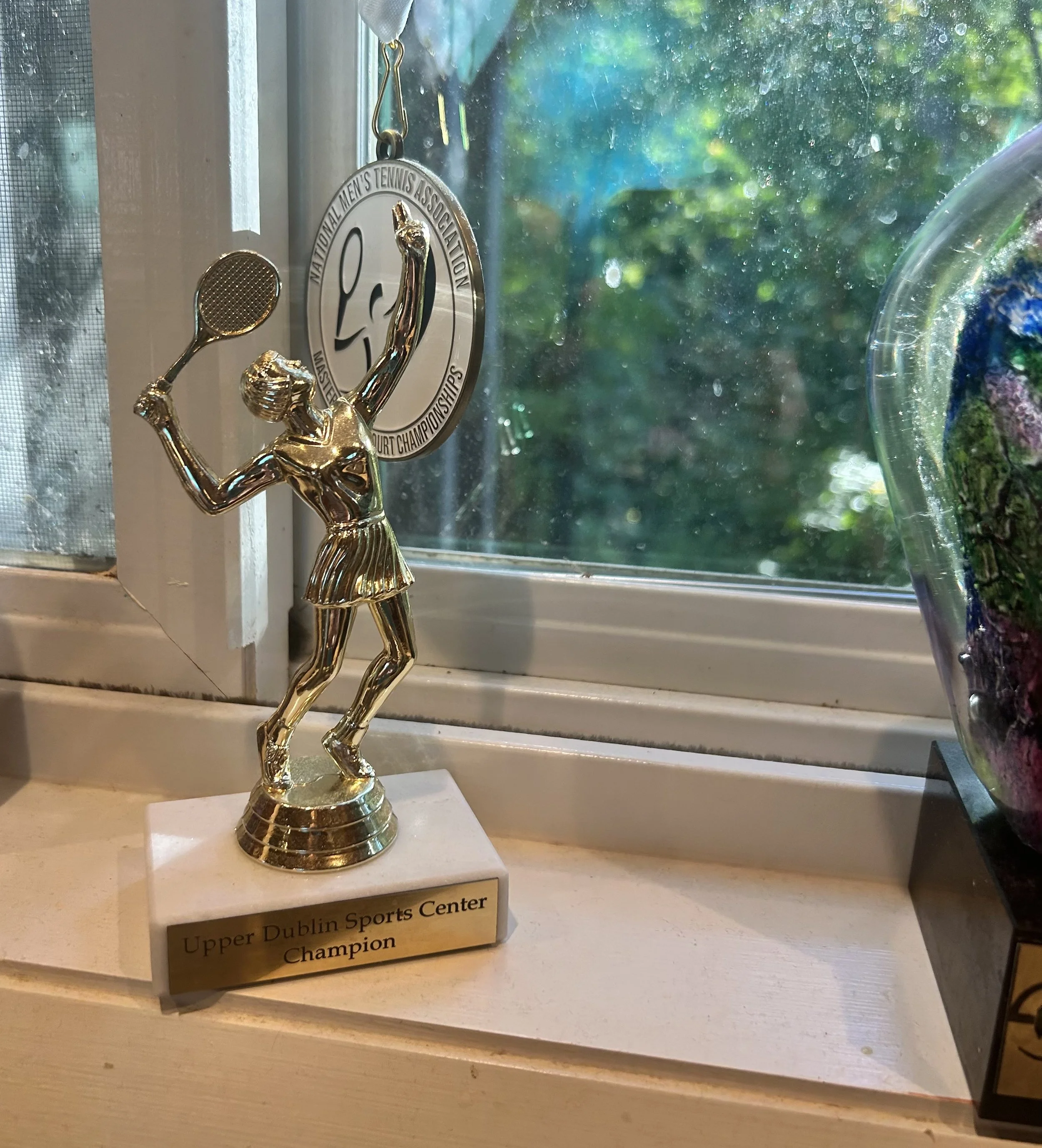A Year of Living Tennisly
I trudge up to the desk of an indoor sports complex, tennis bag over my back, to find an attendant deep into an animated phone conversation with a BFF.
I won!” I say.
“I’m happy for you.” She couldn’t have less happy.
I’m in Ambler, Pennsylvania in mid-March and I’ve just finished winning — no, WINNING! — the “Upper Dublin Spring Starter” tennis event for men 65 years or older. The indoor courts there may have been slick, untended, unheated and 419 miles from home, but I have shown up and taken care of business.
It’s still early in 2025, the year when I’ve committed to trying to get seriously better at tennis. My goal: reach the top 20 among the 500 or so people who sometimes play tournaments like these.
One way to do that is to practice a lot more. Another is to work out -- to get stronger and fitter. You need coaching from smart people who tell you the truth and make you want to get better. But there’s no real substitute for actually playing matches against real people in real tournaments. And the more often you play, the more chances you have to move up in the rankings.
So, Ambler.
… And now I’m at an awkward point of my exchange with the attendant, who just wants me to go away. “So, uh, do I get something for winning?” She looks confused for a second, then remembers. “Oh yeah, right, here’s a trophy.” She reaches under the desk and pulls out a four-inch-high figurine of a male tennis player, serving an imaginary ball, mounted on a faux-marble stand. A little plaque on the base reads “Upper Dublin Sports Center Finalist.”
“But I wasn’t just a finalist — I won,” I say, “Do you have one that says I won?”
This is clearly an annoying question. She grumps to her friend that she’ll have to call her back. Then, to me, “Let me look in the back.”
She comes back a few minutes later with another figurine wrapped in paper. I unwrap it. It’s a figurine of a shapely woman in a cute tennis dress. But the inscription says “Champion.” “Uh, okay, do you have any of those with a man?” “Nope, you can have a boy ‘finalist’ or a girl ‘champion.’”
I take the woman’s trophy and head back home. I need tangible evidence I am making progress.
The Upper Dublin trophy now sits proudly above our sink at home.
**********
This week marked seven months since that tournament in Ambler and I was at the big one now -- joining 143 others at the “National Men’s 60’s and 65’s Clay Court Championships,” held at the beautiful New Orleans Lawn Tennis Club, the nation’s oldest, founded in 1876. This was my chance to prove that my hard work had paid off. By Tuesday I’d made it to the third round, and I’d been assigned a match on the geezer equivalent of Center Court Wimbledon: Court 4, the “show” court. A crowd of 20 or so people looked on with occasional interest from a second-story observation deck.
I was facing the number three seed, the guy who had been the runner-up in the previous two national championships. But I was confident I had a chance. I’d played a close match against him in January, and I had definitely gotten better since then.
Could this be the moment for my breakthrough to the bigtime?
*********
Competitive sports of any kind have distinct levels based on age and quality – think high school, college, minor leagues, semipro or international league teams vs. “the majors.” This week I’ve been reading a fascinating book called The Racket, about the minor leagues of professional tennis, written by Irish player Connor Niland, who at one time was ranked as high as #129 among the 2000 or so professional players in the world. He describes in detail the costs – physical and financial – for the 99% who never quite make it in the professional tennis ranks. In Niland’s case, during his seven years of professional tennis, he won $247,686 in prize money (a bit over $35,000/year), far less than the amount he spent on flights, trains, taxis, hotels, food, entry fees, coaching, equipment, health care and taxes.
Playing in the old age division of tennis, I’ve had the same categories of expenses this year as Conor, and my winnings this year are, uhh, exactly zero (there are a couple of tournaments that offer prize money for the winners and runners up; I wasn’t one of those people). On the other hand, can you really put a value on the two party platters I earned for winning the “Chik-Fil-A Open” in Anderson, SC or the serving tray that comes with winning the Walter Rapp-Shirley Frye Senior Jubilee in Hartford, Connecticut?
Here’s a photo of the serving tray. The cost of gas, food and hotel may have slightly exceeded its trade-in value….
Playing the old people’s circuit has other similarities to the minor league tennis tour, albeit without the passport stamps.
· The elite players can afford to play just a few tournaments, which carry a huge number of ratings points and are held in major cities across the world. Conor played in some of the least exotic locales of five continents, from subzero Siberia and sweltering South America. To build my confidence and try to improve my ranking, I played in smaller tournaments in Ambler and Anderson and Hartford, plus Columbus, Georgia.
· To save money, Conor stayed in sketchy motels; ate cheap. Ditto for me.
· Conor spent much of his time nursing injuries and second-guessing his choices. I’ve done a lot of that too.
But going into New Orleans, it felt like the schlepping had paid off. I’d won three lower-rung tournaments and was runner-up in a medium-sized one. I’d played well in a couple of previous national tournaments. And along the way I’d learned what I thought were critical insights.
Thin for the win. Someone at the tournament asked one of the better players what it took to be successful in senior tennis. I have found the most important thing is…” he said, as I leaned in to make sure I heard this wisdom, “…to be skinny.” He’s not wrong. If you are older, wanting to run all over the court for a couple of hours and avoid injury, you need to embrace your inner ectomorph. And people know it: there may not be blood doping on the senior tour, but there are definitely already-fit players my age taking Ozempic to get even skinnier.
Somebody feed these people! The best players all seem to have a distinctive lean and hungry look….
Add weapons. The best players have options: when one gameplan isn’t working, they shift from Plan A to Plan B and C. Over the course of the year, I’ve been working on a new crosscourt forehand and topspin backhand that I can use in particular situations.
Brain>biceps. In the tournaments I’d done well in, I could look across the net and see something on the face of the people I was playing: they didn’t believe they were going to win. As my big day in New Orleans began, I was 13-3 for the year. But every match I had lost, I lost mostly with my head. I was winning almost half of the points, but losing most of the close games. This match was where I would find out: was my head’s extreme makeover complete?
Embrace chaos. Over the course of this year I’ve run into all sorts of weird situations. The courts in Ambler were like an ice skating rink. It was frigid in Anderson; hella humid in Naples, Florida. The main court in Hilton Head, SC was under a giant osprey’s nest (and the ospreys were hunting). There was construction underway in Rumson, NJ. The winds in Columbus, GA were so bad that one of my opponents’ shots blew back onto his side of the net before I could even reach it. But the conditions are the same on both sides of the net. I’ve learned that if I can convince myself I am bothered less than my opponent, I’ll have an advantage.
Winning>losing. In the movie Talladega Nights, race car driver Ricky Bobby lived by the mantra that “If you ain’t first, you’re last.” That’s not statistically true, of course (as his dad says in the movie, “Hell, Ricky, you could be second, or third. You could even be next to last!”), but it is almost always true that winning is better than losing. Why wouldn’t you do everything you can within reason to win every time?
*********
Loaded with insights, I walked onto Court 4 in New Orleans with confidence.
My opponent served first. Won easily. I served next and settled in to a game that went on… forever. My ad to win. Then deuce. His ad to win. Then deuce. Rinse, repeat. Ten minutes in to the game, he hit a crosscourt winner off the line that I could only wave to as it passed. Down 0-2.
And then, sometime during the next half hour — maybe since this was New Orleans — I remember thinking about a line from a French poem by Arthur Rimbaud (maybe not what you want to be thinking about during a tennis match?): “Après, le deluge.” -- basically, “and then came the flood.” He’d gotten better since the last time we played. I played like a schlub. We didn’t say much to each other — he seemed to say “out” a lot and I mostly said “wow.” Between games, I tried to hide under one of the tiny green hand towels on the court, but I wasn’t skinny enough. I stayed close in 10 of the next 12 games. And lost 10 of the next 12 games. It was a rout.
Afterward, my wife, on hand for her first senior tournament (possibly trying to figure out what the heck I had been doing all year?), asked earnestly, “Um, are you gonna be okay?” My doubles partner, who can generally find something positive to say about any situation, was stumped on this one. Friends I had made over the course of the year avoided eye contact afterward, saying things like “So… where are you eating tonight?” Or “How’s the doubles looking?” (We bounced out of the doubles the following day, also in the third round – another spanking).
“DOMCON 2025” was also being held this week in New Orleans. After my spankings on the tennis court, I didn’t need to go.
So les bon temps didn’t rouler in NOLA. Turns out that even though I was less fat, I wasn’t skinny enough. The new weapons I thought I had acquired instead misfired.
My imagined accumulation of mental muscle melted under pressure into the consistency of pureed gumbo.
And the only chaos I controlled was faithfully flipping the scorecard on the court as the score mounted against me. As the year winds up, I’m a long way from last, but a light year from first: I’m going to fall short of my goal of making the top 20.
But enough self-pity. I have my marching orders for the next year.
Get thin.
Shots with more spin.
More matches with younger men.
When there’s a chance, bring kin.
For number of tournaments, try ten.
If I want to win, get my head to Zen.
Let’s see, the first tournament of next year is in Naples, Florida in mid-January. By then I could lose ten pounds and fix my backhand. I already know a hotel where I can get a good deal. And maybe if I show my opponent the Upper Dublin trophy before the match I can seize the mental advantage …
Notes:
New Orleans Lawn Tennis Club: https://www.myneworleans.com/nostalgia-new-orleans-lawn-tennis-club/
If you ain’t first, you’re last: https://www.youtube.com/shorts/cxcgrWCGlcc?feature=share
Apres le deluge: https://enzomartinelli.wordpress.com/2025/04/17/apres-le-deluge-by-rimbaud-en/



